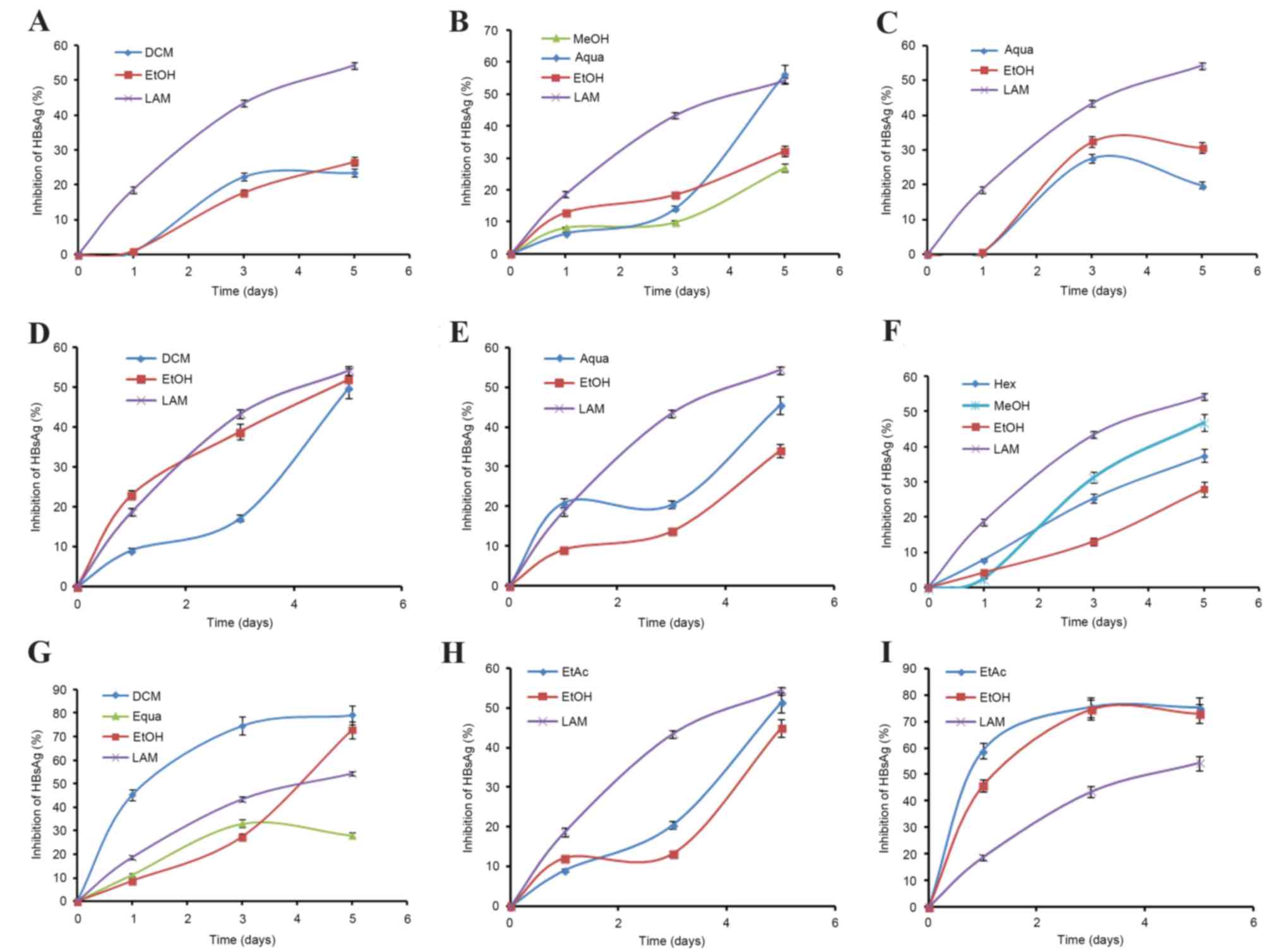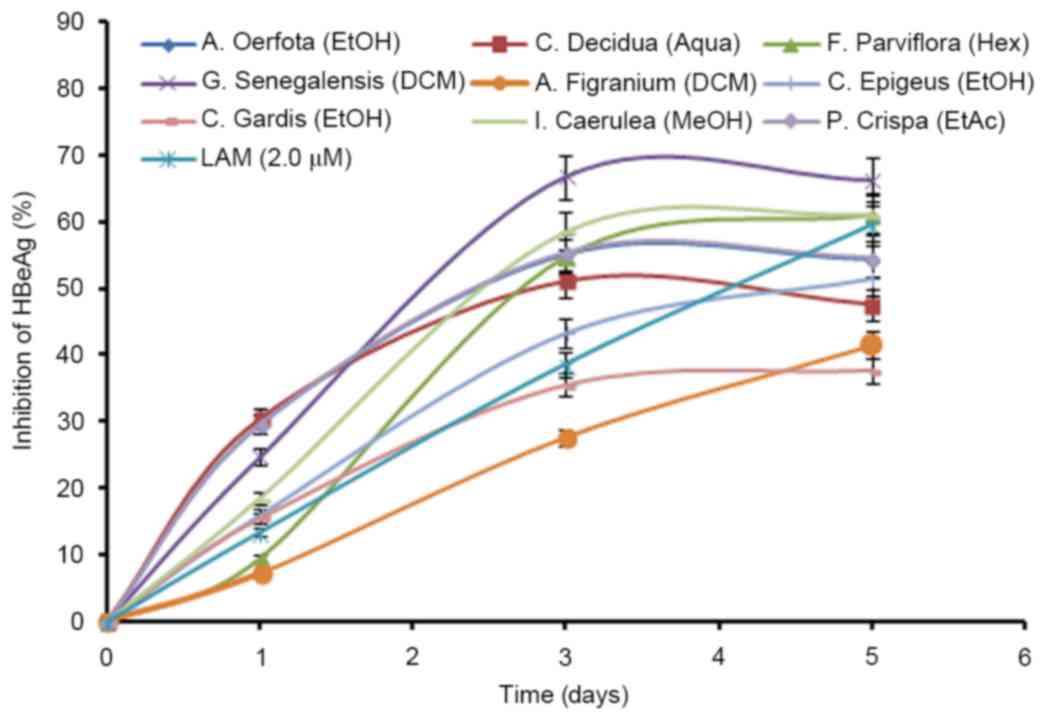|
1
|
Teo CG and Locarnini SA: Potential threat
of drug-resistant and vaccine-escape HBV mutants to public health.
Antivir Ther. 15:445–449. 2010. View
Article : Google Scholar : PubMed/NCBI
|
|
2
|
Torresi J: Hepatitis B antiviral
resistance and vaccine escape: Two sides of the same coin. Antivir
Ther. 13:337–340. 2008.PubMed/NCBI
|
|
3
|
Lok AS, Zoulim F, Locarnini S,
Bartholomeusz A, Ghany MG, Pawlotsky JM, Liaw YF, Mizokami M,
Kuiken C and Hepatitis B; Virus Drug Resistance Working Group, :
Antiviral drug-resistant HBV: Standardization of nomenclature and
assays and recommendations for management. Hepatology. 46:254–265.
2007. View Article : Google Scholar : PubMed/NCBI
|
|
4
|
Locarnini S: Primary resistance, multidrug
resistance, and cross-resistance pathways in HBV as a consequence
of treatment failure. Hepatol Int. 2:147–151. 2008. View Article : Google Scholar : PubMed/NCBI
|
|
5
|
Chen Y and Zhu J: Anti-HBV effect of
individual traditional chinese herbal medicine in vitro and in
vivo: An analytic review. J Viral Hep. 20:445–452. 2013. View Article : Google Scholar
|
|
6
|
Qiu LP and Chen KP: Anti-HBV agents
derived from botanical origin. Fitoterapia. 84:140–157. 2013.
View Article : Google Scholar : PubMed/NCBI
|
|
7
|
Parvez MK, Arbab AH, Al-Dosari MS and
Al-Rehaily AJ: Antiviral natural products against chronic hepatitis
B: Recent developments. Curr Pharm Des. 22:286–293. 2016.
View Article : Google Scholar : PubMed/NCBI
|
|
8
|
Wu YH: Naturally derived anti-hepatitis B
virus agents and their mechanism of action. World J Gastroenterol.
22:188–204. 2016. View Article : Google Scholar : PubMed/NCBI
|
|
9
|
Chen HC, Chou CK, Lee SD, Wang JC and Yeh
SF: Active compounds from Saussurea lappa Clarks that suppress
hepatitis B virus surface antigen gene expression in human hepatoma
cells. Antiviral Res. 27:99–109. 1995. View Article : Google Scholar : PubMed/NCBI
|
|
10
|
Chou SC, Huang TJ, Lin EH, Huang CH and
Chou CH: Anti-hepatitis B virus constituents from Solanum
erianthum. Nat Prod Commun. 78:153–156. 2012.
|
|
11
|
Li J, Huang H, Zhou W, Feng M and Zhou P:
Anti-hepatitis B virus activities of Geranium carolinianum L.
extracts and identification of the active components. Biol Pharma
Bull. 31:743–747. 2008. View Article : Google Scholar
|
|
12
|
Rahman MA, Mossa JS, Al-Said MS and
Al-Yahya MA: Medicinal plant diversity in the flora of Saudi Arabia
1: A report on seven plant families. Fitoterapia. 75:149–161. 2004.
View Article : Google Scholar : PubMed/NCBI
|
|
13
|
Al-Asmari AK, Al-Elaiwi AM, Athar MT,
Tariq M, Al Eid A and Al-Asmary SM: A review of hepatoprotective
plants used in saudi traditional medicine. Evid Based Complement
Alternat Med. 2014.8908422014.PubMed/NCBI
|
|
14
|
van Meerloo J, Kaspers GJ and Cloos J:
Cell sensitivity assays: The MTT assay. Methods Mol Biol.
731:237–245. 2011. View Article : Google Scholar : PubMed/NCBI
|
|
15
|
Satyajit D, Sarkar ZL and Gray AI: Natural
Products Isolation. Humana Press; Totowa, NJ, USA: 2nd. 2006
|
|
16
|
Kar A: Pharmacognosy and
Pharmacobiotechnology. New Age International; New Delhi, India:
2nd. 2007
|
|
17
|
Tiwari P, Mandeep BK, Kaur KG and Kaur H:
Phytochemical screening and extraction: A review. Interl Pharma
Sci. 1:98–1062. 2011.
|
|
18
|
Hantz O and Zoulim F: Duck hepatitis B
virus primary hepatocyte culture model. Methods Mol Med.
96:189–197. 2004.PubMed/NCBI
|
|
19
|
Engler OB, Dai WJ, Sette A, Hunziker IP,
Reichen J, Pichler WJ and Cerny A: Peptide vaccines against
hepatitis b virus: From animal model to human studies. Mol Immunol.
38:457–465. 2001. View Article : Google Scholar : PubMed/NCBI
|
|
20
|
Thung SN, Gerber MA, Purcell RH, London
WT, Michalik KB and Popper H: Animal model of human disease:
Chimpanzee carriers of hepatitis B virus. Chimpanzee hepatitis B
carriers. Am J Pathol. 105:328–332. 1981.PubMed/NCBI
|
|
21
|
Aljofan M, Netter HJ, Aljarbou AN, Hadda
TB, Orhan IE, Sener B and Mungall BA: Anti-hepatitis B activity of
isoquinoline alkaloids of plant origin. Arch Virol. 159:1119–1128.
2014. View Article : Google Scholar : PubMed/NCBI
|
|
22
|
Bonino F, Hoyer B, Nelson J, Engle R,
Verme G and Gerin J: Hepatitis B virus DNA in the sera of HBsAg
carriers: A marker of active hepatitis B virus replication in the
liver. Hepatology. 1:386–391. 1981. View Article : Google Scholar : PubMed/NCBI
|
|
23
|
Arbab AH, Parvez MK, Al-Dosari MS,
Al-Rehaily AJ, Al-Sohaibani M, Zaroug EE, AlSaid MS and Rafatullah
S: Hepatoprotective and antiviral efficacy of Acacia mellifera
leaves extracts against hepatitis B virus. Biomed Res Int.
2015:9291312015. View Article : Google Scholar : PubMed/NCBI
|
|
24
|
Akuodor GC, Essien AD, David-Oku E,
Chilaka KC, Akpan JL, Ezeokpo B and Ezeonwumelu JO:
Gastroprotective effect of the aqueous leaf extract of Guiera
senegalensis in albino rats. Asian Pacific J Trop Med. 6:771–775.
2013. View Article : Google Scholar
|
|
25
|
Silva O, Serrano R and Gomes ET: Botanical
characterization of Guiera senegalensis leaves. Microsc Microanal.
14:398–404. 2008. View Article : Google Scholar : PubMed/NCBI
|
|
26
|
Abubakar MS, Sule MI, Pateh UU, Abdurahman
EM, Haruna AK and Jahun BM: In vitro snake venom detoxifying action
of the leaf extract of Guiera senegalensis. J Ethnopharmacol.
69:253–257. 2000. View Article : Google Scholar : PubMed/NCBI
|
|
27
|
Silva O, Barbosa S, Diniz A, Valdeira ML
and Gomes E: Plant extracts antiviral activity against herpes
simplex virus type 1 and African swine fever virus. Interl J
Pharmacog. 35:12–16. 1997. View Article : Google Scholar
|
|
28
|
Diouf A, Cisse A, Gueye SS, Mendes V, Siby
T, Diop RM Diouf and Bassene E: Toxocological study of Guiera
senegalensis Lam (Combretaceae). Dakar Med. 45:89–94. 2000.(In
French). PubMed/NCBI
|
|
29
|
Najeeb-ur-Rehman Bashir S, Al-Rehaily AJ
and Gilani AH: Mechanisms underlying the antidiarrheal,
antispasmodic and bronchodilator activities of Fumaria parviflora
and involvement of tissue and species specificity. J
Ethnopharmacol. 144:128–137. 2012. View Article : Google Scholar : PubMed/NCBI
|
|
30
|
Ali H, König GM, Khalid SA, Wright AD and
Kaminsky R: Evaluation of selected Sudanese medicinal plants for
their in vitro activity against hemoflagellates, selected bacteria,
HIV-RT and tyrosine kinase inhibitory, and for cytotoxicity. J
Ethnopharmacol. 83:219–228. 2002. View Article : Google Scholar : PubMed/NCBI
|
|
31
|
Ali SA, Gameel AA, Mohamed AH and Hassan
T: Hepatoprotective activity of Capparis decidua aqueous and
methanolic stems extracts against carbon tetrachloride induced
liver histological damage in rats. J Pharmacol Toxicol. 6:62–68.
2011. View Article : Google Scholar
|
|
32
|
Nutan M, Modi C, Dezzutti CS, Kulshreshtha
S, Rawat AK, Srivastava SK, Malhotra S, Verma A, Ranga U and Gupta
SK: Extracts from Acacia catechu suppress HIV-1 replication by
inhibiting the activities of the viral protease and tat. Virology
J. 10:3092013. View Article : Google Scholar
|
|
33
|
Dhivya R, Enzo AP, Tiong CY, Lim SL Diana,
Chu LT, Francois M and Lara G: Evidence of synergistic activity of
medicinal plant extracts against neuraminidase inhibitor resistant
strains of influenza viruses. Adv Microbiol. 4:1260–1277. 2014.
View Article : Google Scholar
|
|
34
|
Niazi J, Singh P, Bansal Y and Goel RK:
Anti-inflammatory, analgesic and antipyretic activity of aqueous
extract of fresh leaves of Coccinia indica. Inflammopharmacology.
17:239–244. 2009. View Article : Google Scholar : PubMed/NCBI
|
|
35
|
Gopalakrishnan V, Rao KN, Devi M, Padmaha
N, Lakshmi PM, Srividya T and Vadivukarasi G: Antihepatotoxic
acticity of Coccinia indica. Anc Sci Life. 21:12–15.
2001.PubMed/NCBI
|
|
36
|
Rangu MV, Suresh B, Sandeep VN, Narendra N
and Ramesh M: Hepatoprotective activity of leaves of Corallocarpus
epigaeus in carbon tetrachloride induced rats. Interl J Biol Pharma
Res. 3:567–570. 2012.
|
|
37
|
Madrigal-Santillán E, Madrigal-Bujaidar E,
Álvarez-González I, Sumaya-Martínez MT, Gutiérrez-Salinas J,
Bautista M, Morales-González Á, García-Luna y González-Rubio M,
Aguilar-Faisal JL and Morales-González JA: Review of natural
products with hepatoprotective effects. World J Gastroenterol.
20:14787–14804. 2014. View Article : Google Scholar : PubMed/NCBI
|
|
38
|
Wohlfarth C and Efferth T: Natural
products as promising drug candidates for the treatment of
hepatitis B and C. Acta Pharmacol Sin. 30:25–30. 2009. View Article : Google Scholar : PubMed/NCBI
|
|
39
|
Liu J, McIntosh H and Lin H: Chinese
medicinal herbs for chronic hepatitis B: A systematic review.
Liver. 21:280–286. 2001. View Article : Google Scholar : PubMed/NCBI
|
|
40
|
Mehrotra R, Rawat S, Kulshreshtha DK,
Patnaik GK and Dhawan BN: In vitro studies on the effect of certain
natural products against hepatitis B virus. Indian J Med Res.
92:133–138. 1990.PubMed/NCBI
|
|
41
|
Huang RL, Huang YL, Ou JC, Chen CC, Hsu FL
and Chang C: Screening of 25 compounds isolated from Phyllanthus
species for anti-human hepatitis B virus in vitro. Phytother Res.
17:449–453. 2003. View Article : Google Scholar : PubMed/NCBI
|
|
42
|
Ott M, Thyagarajan SP and Gupta S:
Phyllanthus amarus suppresses hepatitis B virus by interrupting
interactions between HBV enhancer I and cellular transcription
factors. European J Clin Invest. 27:908–915. 1997. View Article : Google Scholar
|
|
43
|
Mehortra R, Rawat S, Kulshreshtha DK,
Goyal P, Patnaik GK and Dhawan BN: In vitro effect of Phyllanthus
amarus on hepatitis B virus. Indian J Med Res. 93:71–73.
1991.PubMed/NCBI
|
|
44
|
Cheng YC, Ying CX, Leung CH and Li Y: New
targets and inhibitors of HBV replication to combat drug
resistance. J Clin Virol. 34 Suppl 1:S147–S150. 2005. View Article : Google Scholar : PubMed/NCBI
|
|
45
|
Guo Q, Zhao L, You Q, Yang Y, Gu H, Song
G, Lu N and Xin J: Anti-hepatitis B virus activity of wogonin in
vitro and in vivo. Antiviral Res. 74:16–24. 2007. View Article : Google Scholar : PubMed/NCBI
|
|
46
|
Li J, Huang H, Feng M, Zhou W, Shi X and
Zhou P: In vitro and in vivo anti-hepatitis B virus activities of a
plant extract from Geranium carolinianum L. Antiviral Res.
79:114–120. 2008. View Article : Google Scholar : PubMed/NCBI
|
|
47
|
Jiang Y, Zhang XM, Zhang FX, Liu N, Zhao
F, Zhou J and Chen JJ: A new triterpene and anti-hepatitis B virus
active compounds from Alisma orientalis. Planta Med. 72:951–954.
2006. View Article : Google Scholar : PubMed/NCBI
|
|
48
|
Wu YR, Ma YB, Zhao YX, Yao SY, Zhou J,
Zhou Y and Chen JJ: Two new quaternary alkaloids and anti-hepatitis
b virus active constituents from Corydalis saxicola. Planta Medica.
73:787–791. 2007. View Article : Google Scholar : PubMed/NCBI
|
|
49
|
Chiang LC, Ng LT, Liu LT, Shieh DE and Lin
CC: Cytotoxicity and anti-hepatitis B virus activities of
saikosaponins from Bupleurum species. Planta Med. 69:705–709. 2003.
View Article : Google Scholar : PubMed/NCBI
|
|
50
|
Li Z, Li LJ, Sun Y and Li J:
Identification of natural compounds with anti-hepatitis B virus
activity from Rheum palmatum L. ethanol extract. Chemotherapy.
53:320–326. 2007. View Article : Google Scholar : PubMed/NCBI
|
|
51
|
Huang TJ, Tsai YC, Chiang SY, Wang GJ, Kuo
YC, Chang YC, Wu YY and Wu YC: Anti-viral effect of a compound
isolated from Liriope platyphylla against hepatitis B virus in
vitro. Virus Res. 192:16–24. 2014. View Article : Google Scholar : PubMed/NCBI
|
















